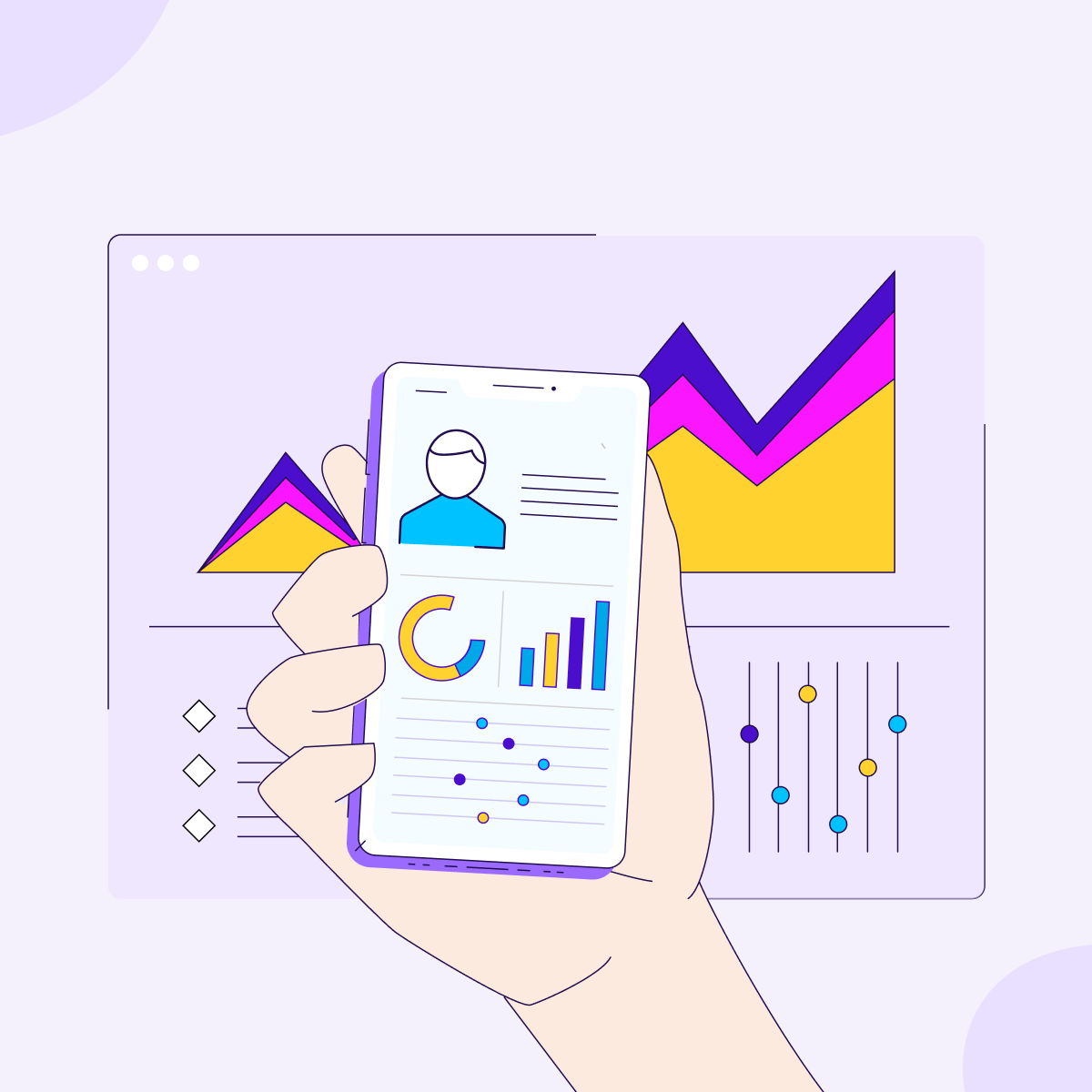What are app KPIs and why are they important?
App KPIs (key performance indicators) measure critical aspects of your app’s performance, letting you see if you’re meeting your objectives and guiding improvements.
Try searching for

To rephrase the age-old question, if an app crashes in a forest and no one hears it — does that app actually crash? If a user rage-quits an app and installs a competitor’s app… OK, you get the point.
Mobile users in major markets spend an average of four to five hours per day in apps — that gives app companies a lot of potential data to work with. If you want people to spend their time on your app, it’s vital to understand what’s working and what’s not, so you can improve the user experience at every stage of their journey.
In this article, we’ll cover some of the critical key performance indicators (KPIs) for apps in three core areas, plus how to track them and perform an app KPI analysis.
KPI stands for “key performance indicator”. In short, a KPI is any measurable piece of data we can attribute to a user. KPIs let you know how well your app performs in critical areas by keeping tabs on the data, processing it, and reporting back to you. Mobile app KPIs enable us to measure every aspect of a user’s interaction with an application.
KPIs are important because they let you measure your app’s performance to see whether you’re achieving your objectives. With app KPIs, your company can set goals, create a strategy to achieve them, and evaluate your progress along the way.
Think of it like a road trip: you set the destination, create your route to get there, and double-check along the way that you haven’t gotten lost or strayed off course.
Mobile app KPIs are becoming increasingly valuable because of the sheer amount of time people spend daily on apps. To put this in perspective, the average time people spend on apps in the top mobile-first markets has increased by over 30% between 2021 and 2022, reaching 4.8 hours daily.
KPIs and app metrics are both quantitative measures, but KPIs relate to business targets, while metrics relate to processes in your company.
That may sound like semantic hairsplitting, so let’s look at an example. With a KPI of increasing engagement on the app, you could measure metrics such as:
Usually, a single department or person owns a metric, while several departments and people within the company contribute to a KPI. For example, if your company aims to sell 30% more subscriptions in a given quarter, multiple departments will likely be involved in achieving this goal.
People use websites and apps in different ways, so your analytics need to focus on different things. Mobile app KPIs differ from website KPIs in several critical ways:
Let’s walk through the main types of app KPIs.
Acquiring new users and generating revenue is the bread and butter of any successful app. Accurate measurement of these KPIs lets you improve them, increasing your company’s profitability over time.
Let’s take a look at a few of them.

What is it? Cost per install (CPI) measures how much you spend to acquire customers after they see an ad for your app. Paid installs are critical here, not organic installs, since CPI helps you see whether your paid ad campaigns are effective.
An advertiser only pays the network after the user has installed the app (not just when they’ve seen the ad, which is known as cost per mille, or CPM). Therefore, CPI incentivizes ad networks to place your ad in high-converting locations and target specific audiences. As a result, you get more bang for your buck and less ad-spend bloat.
How do you calculate it? Ad spend / Total number of installs directly tied to the ad campaign
Why does it matter? CPI was the most commonly used metric to measure campaign performance back in the days of $0.99 apps. While the landscape has changed, CPI is still a vital game app metric. You can even set the payout to activate only when a user attains a specific achievement in the game, which is a better indicator of engagement than just a download.
What is it? ROAS measures the revenue you generate for every dollar spent on advertising. If your ROAS is low, your ad spend isn’t generating enough compared to what you’re investing. If your ROAS is high, your ad campaigns are yielding a positive return on investment.
How do you calculate it? [Revenue gained from advertising / Cost of advertising] x 100
Why does it matter? Unlike more granular data like conversion and click-through rates, ROAS shows you the big picture: whether your ads are making you money. You need to track ROAS to know how profitable your campaigns are.
What is it? PF is the number of times that customers purchase from you in a given period.
Loyal users are critical to your company’s success because they generate more revenue than new users. A report from Manta and BIA/Kelsey, for example, found that “a repeat customer spends 67 percent more than a new customer.”
Knowing how often customers return to purchase will give you a better understanding of your success in converting them into repeat customers, which will help you make informed decisions about your customer retention strategy.
How do you calculate it? Total number of purchases over a time period / Total number of users during the same time period
Why does it matter? PF is an effective way to measure user loyalty and spotlight underperforming products. It also lets you identify your most loyal users so that you can do effective lookalike targeting on your remarketing campaigns.
What is it? OCR refers to your conversion volume from unpaid app discovery, including organic search, influencer marketing, related apps in app store listings, and word-of-mouth mentions on social media.
How do you calculate it? Total number of conversions – Total number of paid conversions
Why does it matter? According to BrightEdge, B2B and technology companies generate twice as much revenue from organic search as they do from other channels. So it’s critical to closely track OCR and identify room for improvement in your organic funnel.
What is it? LTV is the most critical KPI for measuring gross revenue. Unlike click-through rates, downloads, and session time, LTV shows you the big picture of your customers’ value.
If your customers don’t convert, spend money in-app, or subscribe, then you know the granular interactions you’re measuring aren’t working. Calculating and improving your LTV helps you optimize your marketing and conversions.
How do you calculate it? Total revenue generated since install date / Total number of users who installed on that date
Why does it matter? LTV, when combined with the average revenue per customer, is an excellent metric for determining the potential monetary value of your users. It’s a critical metric for measuring business health, especially in the free-to-install app economy.
Engagement metrics show how users interact with your application. By examining them, you uncover how users engage with your app, how long they stay with you, and where the weak points are that you need to improve.
It’s cheaper to sell to existing users than to acquire new ones, so measuring and improving existing users’ engagement is a must.

What is it? An MAU is a user who logs an app session in a given month or 30-day period. Keeping track of whether your MAU count is increasing or decreasing is a broad yet helpful way to determine whether your customer retention program is effective. First, define your criteria for an active user, then generate a total of how many users met that criteria in a given month.
How do you calculate it? Total number of users who meet your criteria monthly
Why does it matter? By measuring MAU, your company can improve its marketing strategies and customer experience. For example, you could implement push notifications, in-app messages, or email reminders to target inactive users. To generate sales, you need users who regularly use your product, so targeting this KPI is worthwhile.
What is it? DAU refers to your app’s number of daily users and is a way to measure your app’s popularity and growth potential. Businesses that expect users to interact with an app daily (for example, medication tracker apps) should track DAU.
While there are different definitions of active interaction, an account login is a common example. An online banking app, however, could define an interaction as making a transfer, while an eCommerce app could define it as adding an item to their cart.
How do you calculate it? Total number of users who meet your defined criteria daily
Why does it matter? Many companies regard DAU as a measurement of success. The more users interact with an app every day, the stickier the app is.

What is it? Retention rate is the percentage of customers staying with your company over a defined period. With apps, retention means keeping app users engaged with your app. Knowing your retention rate will help you increase LTV and improve your in-app events since you have more granular data about when and why users leave your app.
How do you calculate it? Total number of active users who were active on a specific period of time since installation / Total number of users who launched the app for the first time during the selected date range
Why does it matter? Reducing churn and holding onto users is critical to an app’s success.
What is it? Uninstall rate refers to the rate at which users uninstall your app within a defined period. It lets you compare the quality of users based on the marketing channels, individual ads, countries, or other criteria.
Uninstalls can happen for various reasons, including:
How do you calculate it? Total number of uninstalls within a predefined window / Total number of installs during a set time frame
Why does it matter? A 2020 analysis found that users uninstall almost half of all apps within 30 days of installation. Plus, the average app loses approximately $33,000 per month due to uninstalls. With stats like that, it’s easy to see why tracking the uninstall rate is critical for your company’s success.
What is it? The funnel conversion rate is how fast people move through your app’s funnel. To figure this out, you first map out key in-app events in your funnel. Then you measure the conversion rate between any two defined events (for example, install to purchase).
How do you calculate it? [Total number of desired event conversions / Total number of initial events in the app] x 100
Why does it matter? Conversion rates for funnels can help you see where your sales and marketing processes are out of sync. By establishing and measuring critical funnel metrics, you can find the places where your funnel is leaking — and fix them.
Performance KPIs are closely tied to engagement KPIs because if an app frequently crashes, it will, of course, lose users. On the other hand, if users can easily click a link in an email and get exactly where they need to go in the app, you’re more likely to retain them.
What is it? App load speed refers to the time users have to wait before they can start interacting with your app (in other words, how long between when they tap and when the action actually starts).
Many factors can play into this critical part of app performance, including:
How do you calculate it? Measure your app’s load speed by using KPI monitors that record messages the app sends when defined events occur. The back-end development this requires is worth it because you’ll know exactly how long your users are waiting between events.
Why does it matter? You’ll lose users if your app takes too long to load, so measuring and improving this KPI is key to your app’s success.
What is it? Crash reports show the exact time a crash occurs, the cause, and the location. These reports are essential to improving your app development and maintenance processes. Plus, they let your company’s developers spend less time troubleshooting in-app bugs.
The best way to lower your crash rate is to set a benchmark and improve it using testing and code review processes. From there, you begin to understand which errors directly affect user experience so you can prioritize development time.
How do you calculate it? The number of app launches in a period / The number of crashes in the same period
Why does it matter? App users have higher and higher expectations for app performance as time goes by, and reducing your crashes will reduce your uninstalls. To keep more users, track and improve your crash rate.

What is it? In the context of apps, deep linking refers to delivering users to specific in-app content from wherever they are. You can place a deep link anywhere, such as in a text message, an email, an Instagram post, or a QR code. With a deep linking engine, your company can do things like send an email to existing users with a link that directs them to an in-app product page.
To implement deep linking, use a tool like AppsFlyer, which lets you easily create deep links to boost installs, retention, and in-app purchases, among other events.
Why does it matter? Deep linking delivers up to six times higher conversion rates than generic journeys, which lack contextualization and personalization. Additionally, deep linking gives brands a 110% boost in day 30 retention rates when used to customize welcome messages and onboarding processes. It’s a huge missed opportunity for apps to get more out of the traffic and users they already have.
Now that you’ve gathered all that data, what are you going to do with it? Here’s how to analyze your KPIs and track your progress:
App KPIs (key performance indicators) measure critical aspects of your app’s performance, letting you see if you’re meeting your objectives and guiding improvements.
Key acquisition KPIs include cost per install (CPI), return on ad spend (ROAS), purchase frequency, organic conversion rate (OCR), and lifetime value. These help you assess how effectively your app attracts and converts new users.
Load speed impacts user experience directly. Apps that load slowly risk losing users, making this a crucial KPI to track and optimize for retention.
Deep linking delivers users directly to specific in-app content, boosting conversion and retention rates by creating a more personalized and frictionless experience.
MAU measures active users in a month, offering a broad view of retention, while DAU measures daily activity, indicating your app’s day-to-day stickiness.